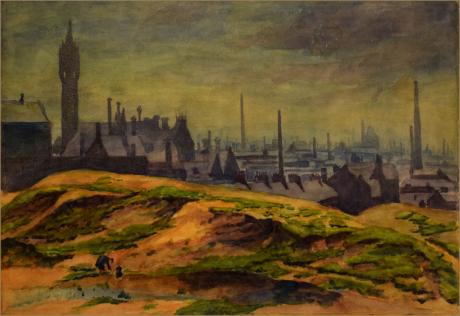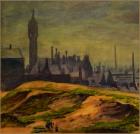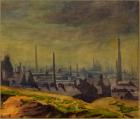inscribed and signed on the reverse " Assize Courts / from Cheetwood / Vincent Reade"
The Manchester Assize Courts were law courts on Great Ducie Street in the Strangeways district of Manchester, England. It was 279 ft (85 m) tall and from 1864 to 1877 the tallest building in Manchester. Widely admired, it has been referred to as one of Britain's 'lost buildings'. The Assize Courts was the first civic building to be constructed in Manchester after the town hall on King Street by Francis Goodwin in 1819. The Builder described it as the most important building outside Whitehall. Its design was the result of a competition in 1858 that attracted more than 100 entries. The competition was won by Alfred Waterhouse whose design beat schemes from other renowned architects such as Thomas Worthington and Edward Walters.
Waterhouse designed the building in the Venetian Gothic style, construction began in 1859 and was completed in 1864. As part of the scheme, the nearby 1862 Strangeways Prison was included in his design and is currently a Grade II listed structure.
The building contained exterior sculptures by Thomas Woolner and the firm of O'Shea and Whelan. They depicted lawgivers from history, along with a "drunk woman", a "good woman", a scene of the Judgment of Solomon and carvings depicting different punishments throughout history.
As part of the court system changes, the assize court system in Manchester was abolished in 1956 and changed to the Crown Court system. The courts building was severely damaged in the Manchester Blitz in 1940 and 1941. It was said that everything was destroyed except the Great Ducie Street facade and judges' lodgings. Some buildings in the city damaged in the war were repaired but Manchester Assize was demolished soon after the assize court abolition in 1957. Some of the sculptures were preserved and incorporated into the new magistrates'
Strangeways is an area of inner north Manchester, England, around Strangeways Prison just north of the city centre.Until the 19th century, Strangeways was rural, with Strangeways Hall, Park and Gardens. Strangeways was recorded in 1322 as Strangwas, from the Anglo-Saxon Strang and gewæsc meaning "[a place by] a stream with a strong current". HM Prison Manchester (commonly known as Strangeways) is a high-security men's prison operated by Her Majesty's Prison Service. It is a local prison, holding prisoners remanded into custody from courts in the Manchester area and Category A prisoners whose escape would be highly dangerous.
Strangeways was designed by Alfred Waterhouse and opened in 1868 alongside the demolished Manchester Assize Courts. The prison is known for its prominent ventilation tower and imposing design, structured by the principles of the separate system. It was rebuilt following a major riot in 1990. Strangeways Brewery was famous as the home of Boddingtons Bitter. It closed in 2005 and was demolished in 2007.
1459: First known mention of the de Strangeways family in the area.
1544: A settlement document describes widespread property attached to Strangeways Hall, including 24 houses, 20 town properties, 20 cottages, and various land up to several miles away.
1641: Strangeways Hall appears on a map. It was in Elizabethan or Jacobean style.
1624: John Hartley (1609-1655) bought Strangeways Hall. His father Nicholas Hartley and elder brother Richard were wool merchants in Manchester.
Early 18th century: A grey stucco, palladian-style addition to Strangeways Hall was built.
1713: The Reynolds family took over the hall.
1768: Francis Reynolds granted a lease to Robert Norton to build a house and silk dyeing works by the Hall's fish pond.
1777: Strangeways Hall first known to be let to a tenant (Hugh Oldham).
1788: Strangeways Hall was run as a girls' boarding school.
1816: Start of the area being built over with houses.
1838: Land in Strangeways area was sold to the Manchester and Leeds Railway Company; Manchester Victoria station is there now.
1858: Strangeways Hall demolished and its materials sold
1859: A newspaper report that the Hall was "several times rebuilt".
1864: Completion of building of the Assize Courts on the site of Strangeways Hall. (It was destroyed in the 1939-1945 Blitz and its site is now a car park on Great Ducie Street).
1868: Strangeways Prison opened. It was built on the site of Strangeways Hall's fish ponds.
late 19th century: Jewish immigration to the area, fleeing from violence in Russia.
Albert Vincent Reade was born in 1864, he was a portrait, landscape and still life painter. He studied at the Manchester Academy of Fine Arts and Colarossi's Paris, He exhibited between 1901 and 1933 and lived in Manchester.



